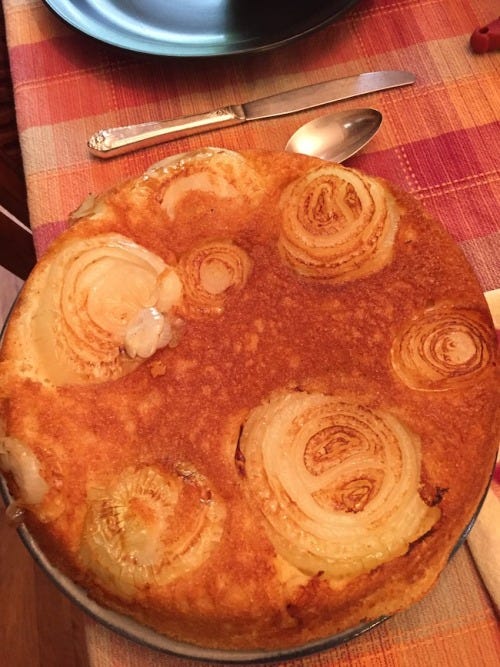I have been thinking about onions this week after sampling a sweet onion out of Upstate South Carolina that was new to me. It’s called the Winzo onion, and we found them on a family farm and produce stand in the town of Winzo. The name might be short for wind zone. The magnolias grew very tall there, and It was so windy, the magnolias seemed to be chattering beside the farmstead. SC 9 also rides something of a ridge all the way from Mt. Croghan through Winzo and into the larger town of Pageland, where apparently these onions can also be purchased in the local farmers’ market. I wish I’d bought a whole bag to sample them more thoroughly.
Vidalia onions cooked in the bottom of a skillet of cornbread with one interloper–the smaller Winzo onion from South Carolina (top middle)
Winzos are more evenly round, and delicate, and not as immediately sweet or large as the Vidalias I grew up eating, but the woman who sold them to me confessed they plant actual Vidalia onion plants in their fields. Winzo onions taste different, she said, because they grow in the local soil.
“Can you do that legally?” I asked. (I thought Vidalias were patented, but they don’t call them Vidalias in Winzo, so I guess it’s okay.)
“People here seem to love them is all I know,” the lady said.
Vidalia onions were an obsession in my Atlanta family in the 1960s, before onion production in the eponymous South Georgia town really geared up and went out of state with its premium product. My friend Sheri Castle just published a piece in Southern Living about Vidalias. She says, “At one time people had to go all the way to Georgia to fetch these onions, so prized that there are stories of women wrapping each onion in a lace doily or linen napkin and nestling them in the drawers of the china cabinet for safe keeping.”
I am sure that might have been true in upscale Buckhead, but in my family my grandmother, aunts, and mother stored their Vidalias in old nylon stockings that they knotted between onions and then threw that lumpy snake in the cool, dark garage or pantry. When they needed an onion, they’d take a pair of scissors to the stocking and liberate one at a time. Stored that way the onions would usually last, without sprouting, long enough for cornbread dressing at Thanksgiving.
Now Vidalias are stockpiled in “controlled atmosphere” warehouses that allow growers to store some 20 million of them for up to six months and stagger their release to markets all the way to the end of the year, according to vidaliaonions.com. At this website I also learned that Vidalia onions were granted legal status, (only legitimate if raised in a 20-county stretch of Georgia), and they were named the official vegetable of the state in 1986. The Vidalia Onion Hall of Fame annually inducts an individual who has played a significant role in protecting and promoting this Georgia treasure.
Softball-sized Texas Sweet onions, which do not compare to Vidalias in my opinion, were created after a million dollars’ worth of ag research was poured into them. Another sweet onion out of Walla Walla, Washington, also has its own band of fanatics who declare that the volcanic terroir in the Northwest creates a more complex flavor than Vidalia dirt does. They also note that Vidalias are hybrids, and Walla Wallas are not, having been imported to the region in 1900 from the island of Corsica, without any alterations over all these years. I wonder why don’t they call them Napoleonions?
What I love about Vidalias is their flattened shape. Most are wider side to side than top to bottom. This architecture, when cut into quarters from the top, produces thick, curved pieces pleasantly nesting inside one another. Raw, they are juicy, smooth, and immanently edible. For other purposes, you may cut the onion from side to side, producing large rounds of concentric rings. It is this preparation that Sheri Castle uses to make her special raw onion sandwiches.
This week, I laid out rounds of Vidalias (and one little Winzo slice) edge to edge in my iron skillet to bathe in a shallow bed of corn oil. I heated the skillet on the stovetop as usual, and then poured in my standard buttermilk, 2 eggs, and Martha White cornmeal mix. I do not measure. I add buttermilk until it looks like the consistency of my grandmother’s batter. Cooked in the oven at 400 degrees until brown, you let it rest for bit and release the edges with a knife if needed. Then flip the round onto a plate for Vidalia-upside-down cornbread. My kitchen smelled like Thanksgiving dressing for two days! The dish was something extra special to go with our turkey and white bean chili that night.As for the Winzo onion, it carmelized wonderfully, but I found it lacking in flavor when I threw the small, raw rings on top of a salad later in the week. For some tender stomachs who are sensitive to the sulphurous burn of a traditional onion, perhaps the mild-mannered Winzo is a winner. I’m sticking with my sweet homies from Georgia.






